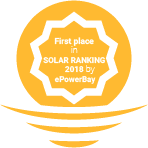When sunlight hits a solar panel, it generates solar power, which is later transformed into electricity that can be consumed by homes and companies. This photovoltaic transformation is how we produce solar energy. In this article, we will explain in detail how a solar power system takes advantage of the sun’s energy.
Solar panels transform the light of the sun into energy
The creation of energy from sunlight begins with the most important part of a solar installation: the solar panel. Usually, a typical solar panel is made from monocrystalline or Polycrystalline silicon placed in a metal frame with a glass cover.
When the light of the sun hits the fine layer of silicon in the upper level of a panel, the atoms of silicon release electrons. The electrons have a negative charge, which means that they are attracted to one side of the silicon cell. This creates an electrical current that is captured by the cables in the solar panel.
This process is known as the “photovoltaic effect”, where the electrons that flow freely thanks to the sunlight are at the core of creating electricity. If more sunlight hits the solar panel, more electrons will be freed, so it is important to consider shadows and local cloud formations when a system of solar energy is designed.
The different solar panels produce electricity at different rates depending on efficiency and quality. High quality solar panels are usually more expense, but long-term they save money as they produce electricity more efficiently.
The inverters transform energy from solar panels into electricity
Once the electrons have gathered in individual panels, the resulting current is known as direct current (DC). The electricity that we use to feed devices, charge electrical car and turn on our lights is an alternating current (AC). The electricity generated by free silicon electrons is DC electricity and it must be turned into AC electricity for us to use.
Devices known as inverters carry out this conversion. Inverters can be configured as string inverters, micro inverters or power optimizers, but each configuration has the same key function: transform DC electricity into AC electricity. Once the DC electricity passes through the inverters, it transforms into AC electricity. This is how the general electric grid can benefit from solar energy.
Most of the available solar panel are made from crystalline silicon, but there are many types of solar panels that can produce electricity.



